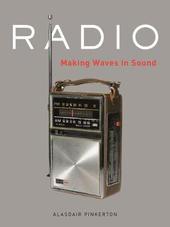
|
Radio: Making Waves in Sound
Hardback
Main Details
| Title |
Radio: Making Waves in Sound
|
| Authors and Contributors |
By (author) Alasdair Pinkerton
|
| Physical Properties |
| Format:Hardback | | Pages:208 | | Dimensions(mm): Height 208,Width 156 |
|
| Category/Genre | Radio
History of engineering and technology |
|---|
| ISBN/Barcode |
9781789140781
|
| Classifications | Dewey:791.44 |
|---|
| Audience | |
|---|
| Illustrations |
80 illustrations, 50 in colour
|
|
Publishing Details |
| Publisher |
Reaktion Books
|
| Imprint |
Reaktion Books
|
| Publication Date |
15 July 2019 |
| Publication Country |
United Kingdom
|
Description
Radio is a medium of apparently endless contradictions. Now in its third century of existence, the technology still seems startlingly modern; despite frequent predictions of its demise, radio continues to evolve and flourish in the age of the Internet and social media. This book explores the history and mythology of the radio, describing its technological, political and social evolution, and how it emerged from Victorian experimental laboratories to become a near-ubiquitous presence in our lives. The book is shaped by radio's multiple characters and characteristics - radio waves occur in nature, but have been harnessed and moulded by human beings to bridge oceans and reconfigure our experience of space and time. An informative and thought-provoking book for all enthusiasts of an old technology that still has the capacity to enthuse, entertain, entice and enrage.
Author Biography
Alasdair Pinkerton is a reader in geopolitics at Royal Holloway, University of London. He is an avid radio listener and has battled to detect shortwave signals from around the world.
Reviews"Pinkerton covers an extensive range of topics, including radar, drones, and 'hate radio, ' investigating, in particular, the role played by Radio Rwanda in the ethnic cleansing of that country in 1993/4. . . . It is very well written and, unlike some academic books, it is very easy to comprehend."-- "RadioUser" "This is a well-illustrated hardback book which adopts a very broad brush approach to the history of radio. It has some interesting content about radio masts, VLF transmissions, radio amateurs, and early days of SW broadcasts."-- "Communication, Books of the Year" "This popular science work details the rise of radio as a communications technology, from early understanding of electromagnetic waves, to harnessing those waves as a means of transmitting sound, to radio's peak as an information and entertainment network. Beginning with an overview of the technological development of radio, Pinkerton focuses subsequent chapters on the social, political, and cultural uses of radio, primarily in the English-speaking world. . . . Well illustrated throughout with photographs and graphic reproductions of historical advertisements."-- "Choice" "Pinkerton's account of the scientific journey towards sending sounds by electromagnetic energy is fascinating, as are the human implications of this technology, all the way from Morse code to mobiles, Crippen's arrest to the age of the podcast. Radio, rather than television, is the greatest popular miracle of the twentieth century. Yet Pinkerton's account stretches back to ancient philosophers, Zeus' monopoly on lightning, and the enduring fascination of both magnetism and electricity. There are many fine nuggets here."--Libby Purves "Times Literary Supplement" "Radio is wonderful: deeply researched, richly kaleidoscopic, beautifully written. Although Pinkerton has big themes to explore--radio's technical origins, its sometimes contradictory cultural impacts, its extraordinary role in building communities, nations, and empires--he embraces all this without ever losing sight of the deeply human nature of his subject: the people who have made radio what it is, and the complex ways in which the global presence of this extraordinary medium shapes our daily lived experience. The result is both immensely fascinating and vitally important."--David Hendy, author of Noise: A Human History of Sound and Listening
|